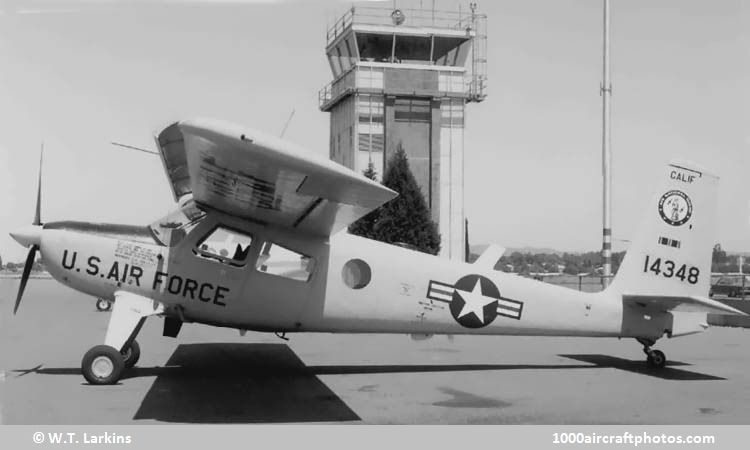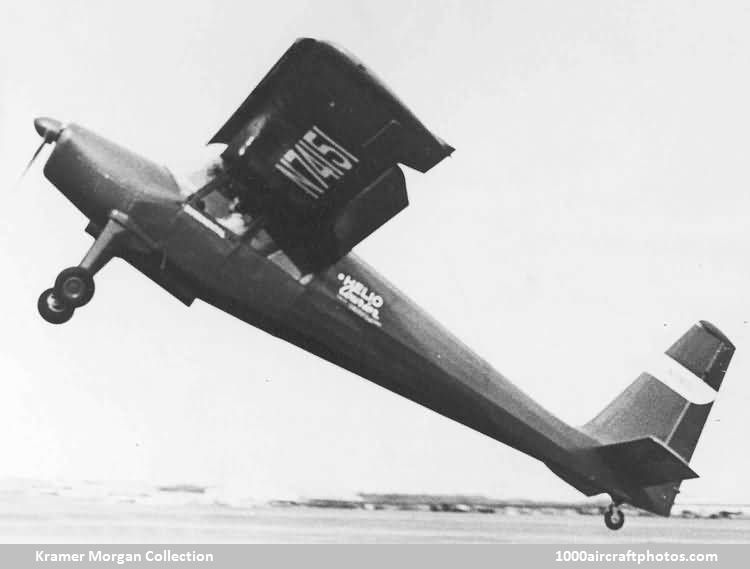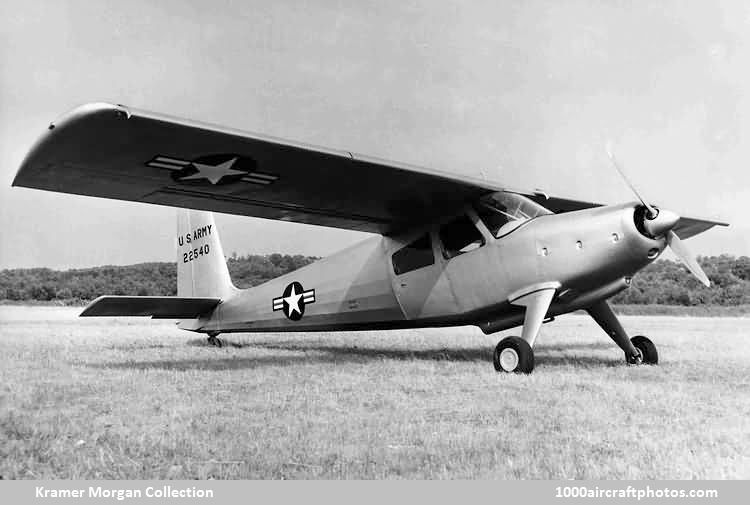W.T. LARKINS MEMORIAL COLLECTION
No. 9946. Helio H-295 U-10D Super Courier (66-14348 c/n 1250) US Air Force
Photographed at Buchanan Field Airport, Concord, California, USA, May 2, 1970, by W.T. Larkins
06/30/2010. Remarks by
Johan Visschedijk: "The remarkable take off and landing characteristics of the Helio Courier have earned it a unique place in General Aviation. The type was the creation of Dr. Otto C. Koppen of the Massachussetts Institute of Technology, and Dr. Lynn L. Bollinger of the Harvard Graduate School of Business Administration, who researched high lift wing design during the late 1940s and early 1950s. For this purpose they formed the Bollinger-Koppen Aircraft Corporation at Cambridge, Massachussetts, in 1948.
Their first prototype, designated Bollinger-Koppen Helioplane, was converted from a Piper PA-17 Vagabond by E.W. Wiggins, a fixed base operator at the Greater Boston Metropolitan Airport at Norwood, Massachussetts, and registered N9390H, it first flew on April 8, 1949. This prototype had very short span wings with automatic leading edge slats and dual purpose aileron/flaps, a lengthened fuselage, redesigned landing gear and a modified rudder. (It is preserved at the
NASM, being donated by Helio in 1963.)
Helioplane-Four (N74151) (
Kramer Morgan Collection)
Its performance was sufficiently encouraging to prompt the designers to build the four-seat Helioplane-Four which was a cantilever high-wing tube and fabric monoplane powered by a 145 hp Continental engine. This incorporated further high lift modifications and showed outstanding low speed performance. Registered N74151, it was flown in 1950, by which time the company had been renamed Helio Aircraft Corporation and had moved to Greater Boston Metropolitan Airport.
Marketed as Helio Courier, it was used as a demonstrator, usually flown by former USMC Colonel William Dean. The demonstrator was lost when it crashed on the way to Canada for demonstration flights, killing Colonel Dean. Helio went on to build three substantially similar tube and fabric production prototypes.
Helio H-391 YL-24 Courier (52-2540) (
Kramer Morgan Collection)
The military significance of the aircraft's abilities was soon apparent, so one of these three prototypes was delivered as a YL-24 to the US Army for evaluation, under the serial 52-2540 (reportedly preserved at US Army Museum, Fort Rucker, Alabama).
In 1953, the all-metal prototype of the Courier (N242B) made its first flight and this was the first step towards full production of the type. The Type Certificate was received on August 5, 1953 and the first five production aircraft were built as the Model 391B in Canada, most likely by Fleet Manufacturing, Ltd. of Fort Erie, Ontario, as this company had received a license for Canadian production by 1954.
Subsequently production was moved to a plant at Pittsburg, Kansas. The Model 391B was the first of a series of Couriers which mainly differed from one another in respect of the power plant employed. The Courier was used in large numbers by the United States armed forces and its short field performance made it especially useful in Vietnam and in the clandestine Air America operations in Laos.
Helio Aircraft Corporation was purchased by General Aircraft Corporation in 1969 and renamed Helio Aircraft Company, five years later, December 1974, it was announced that General Aircraft Corporation was suspending all production and the production rights and tooling for the Courier would be sold to John Roberts Ltd. The exact outcome of this deal is obscure, but the Type Certificate for the Helio designs did eventually pass into the hands of Helio Precision Products who subsequently, in 1976, sold all the assets to Helio Aircraft Ltd. of Pittsburg.
At about this time General Aircraft decided to take legal action against the US Central Intelligence Agency (CIA) on the grounds that they had brought about the company's financial downfall through a scheme to manufacture copies of the Courier without Helio's permission. It seems probable that a significant number of other aircraft were built from spare parts and through the engineering resources of the CIA-sponsored Air Asia.
Helio Aircraft Ltd. waited until the early 1980s to return to production. They designed a new version of the Courier which was based on the H-295 Super Courier but with either a 350 hp Lycoming flat-six engine or a 400 hp Lycoming flat-eight. The Courier 700 and 800 could be operated on either skis or floats in addition to the newly designed polymer composite land landing gear. Output totaled eighteen aircraft but production was halted in 1984. The business was subsequently acquired by Aircraft Acquisitions, but no further aircraft were produced.
The Courier versions produced were:
H-391 Courier, original basic Courier powered by a 260 hp Lycoming GO-435-C2 engine, prototype only, N242B c/n 001.
H-391B Courier, production version of H-391 with 260 hp Lycoming GO-435-C2B engine, 102 produced, c/n 001 to 102
H-392 Strato Courier, H-391B with 340 hp Lycoming GO-480-C1D6 engine, used for high-altitude photography, set world altitude record of 31,200 ft (9,510 m) over Mexico City in October 1957, only one produced.
H-395 Courier, H-391B with 295 hp Lycoming GO-480-G1D6 engine, 138 produced, c/n 502 to 639. Of these 138, six to the USAF as L-28A (later redesignated U-10A), s/n 58-3093 to 58-3096, 58-7026, 58-7027, an additional eight were delivered as U-10A s/n 62-3603 to 62-3608, 63-13184, 63-13185, and 76 as U-10B s/n 62-5907 to 62-5920, 63-8091 to 63-8110, 63-13090 to 63-13113.
H-395A Courier, H-395 with 260 hp Lycoming GO-435-C2B6 engine, seven produced, c/n 1002 to 1008.
H-250 Courier II, H-295 with lengthened fuselage and 250 hp Lycoming O-540-A1A5 engine, 41 produced, c/n 2501 to 2541.
H-291 Super Courier, H-395 with 295 hp Lycoming GO-480-G1D6 engine, single prototype, N9757 c/n 1238.
H-295 Super Courier, production version of H-291, 174 produced 1201 to 1295, 1401 to 1479. Of these 174, 44 to USAF as U-10D, s/n 66-14332 to 66-14375, an additional nine were converted from U-10B, s/n 63-13096 to 63-13099, 63-13102 to 63-13106. The pictured aircraft went into storage on November 12, 1974, in 1979 it came on the civil registry as N5072Q. By 1987 it was fitted with a tricycle landing gear, eventually it was reverted to the original landing gear.
H-700 Courier, H-295 with new landing gear, wing carry-through structure, upturned wing tips and 350 hp Lycoming TIO-540-J2B turbocharged piston engine in new cowling. Combined H-700/H-800 production totaled eighteen, c/n H-1 to H-18.
H-800 Courier, H-700 with 400 hp Lycoming IO-720-A1B engine, prototype N4002M c/n H-l, first flown March 24, 1983. Combined H-700/H-800 production totaled eighteen, c/n H-1 to H-18."


